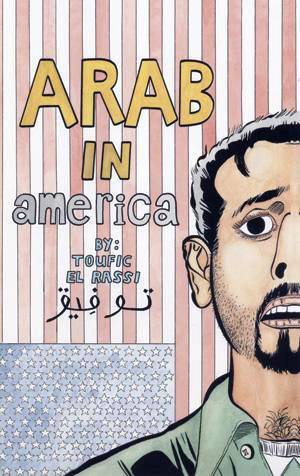Arab in America by Toufic El Rassi
 If the observations, memories, and pop culture references here weren’t so obviously recognizable in our post-9/11 western world, you might have read this graphic memoir as a hack comedy. The black-and-white panels initially seem almost unfinished, as if still in rough-draft mode. The contents might easily be construed as just plain ridiculous: an email reminder sent by a frightened sister to shave on 9/11, a 13-year-old being investigated by the FBI because of a nervous neighbor, learning that “camel jockey” does not mean a horse jockey on a camel even while being called every wrong racist name, wearing a shirt with a Mexican flag to “play it safe at the airport.” Is this what really happens in the good ‘ol US of A?
If the observations, memories, and pop culture references here weren’t so obviously recognizable in our post-9/11 western world, you might have read this graphic memoir as a hack comedy. The black-and-white panels initially seem almost unfinished, as if still in rough-draft mode. The contents might easily be construed as just plain ridiculous: an email reminder sent by a frightened sister to shave on 9/11, a 13-year-old being investigated by the FBI because of a nervous neighbor, learning that “camel jockey” does not mean a horse jockey on a camel even while being called every wrong racist name, wearing a shirt with a Mexican flag to “play it safe at the airport.” Is this what really happens in the good ‘ol US of A?
Welcome to the world of Toufic El Rassi, born in Beirut to an Egyptian mother and a Lebanese father, raised in the U.S. from age one. Even after decades of living an American life, calling El Rassi himself ‘American’ (in spite of his U.S. passport!) seems unfairly far-fetched.
He discovers his brown skin in 8th grade, the same year his beard grows in: “Imagine my shock upon discovering that, in sharp contrast to the angelic white faces arrayed in the chorus, the dark splotch on the grainy tape was me!”
From The Bangles’ dismissable “Walk Like an Egyptian” to The Cure’s more threatening “Killing an Arab,” El Rassi’s childhood soundtrack is filled with guilt. “I felt like I should hide or apologize for something … like I did something wrong and should be ashamed.” Classmates and neighbors harass him in his youth, and as he gets older, his attackers age right along with him.
The ignorance El Rassi encounters is appalling at the very least, but no less life-threatening as “the average American couldn’t distinguish Arabs & Muslims from other nationalities & faiths.” From Rudolph Valentino to Hollywood’s current portrayals, anti-Arab images pervade the big and little screens with racist depictions, continuing to fuel misconceptions of the Arab American identity.
El Rassi attempts to educate the public: “Since there is so much confusion and ignorance it may be useful to explain what an Arab actually is.” From history to semantics to pronunciation lessons, El Rassi places current world events into a less biased context. His battle is still ongoing … because being Arab in a “you’re either with us or with the terrorists”-America remains a contemporary challenge.
In spite of his English-as-a-primary-language existence, El Rassi never stops having to answer, “Do you speak English?” Nope, not with that bearded face! English-speakers of all backgrounds would do well to read this graphic memoir … and someday (soon), perhaps El Rassi’s experiences truly will fall into the realm of the ridiculous rather than the reality he (and too many others like him) face every day.
Readers: Young Adult, Adult
Published: 2007
Sorry, the comment form is closed at this time.

Discussion